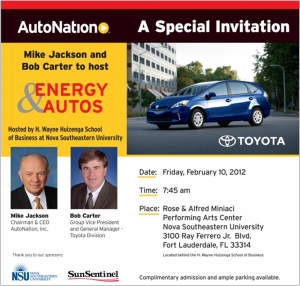NSU Newsroom
SharkBytes
Horizons
This version of NSU News has been archived as of February 28, 2019. To search through archived articles, visit nova.edu/search. To access the new version of NSU News, visit news.nova.edu.
This version of SharkBytes has been archived as of February 28, 2019. To search through archived articles, visit nova.edu/search. To access the new version of SharkBytes, visit sharkbytes.nova.edu.
Automotive Business Leaders to Address Energy & Autos at NSU
 Where else will you have the opportunity to see the premier of the Prius Family of Vehicles? Join the H. Wayne Huizenga School of Business and Entrepreneurship in welcoming two auto world executives to NSU’s campus for a special ENERGY & AUTOS event. The event will be held at 7:45 a.m. on Friday, Feb. 10 in the Rose and Alfred Miniaci Performing Arts Center on NSU’s main campus.
Where else will you have the opportunity to see the premier of the Prius Family of Vehicles? Join the H. Wayne Huizenga School of Business and Entrepreneurship in welcoming two auto world executives to NSU’s campus for a special ENERGY & AUTOS event. The event will be held at 7:45 a.m. on Friday, Feb. 10 in the Rose and Alfred Miniaci Performing Arts Center on NSU’s main campus.
ENERGY & AUTOS panelists include Mike Jackson and Bob Carter. A vocal advocate for the auto industry for many years who has made many appearances before the national media and in the halls of Congress for a renewed energy policy, gas taxes and enhancing efficiency standards, Jackson is chairman and chief executive officer of AutoNation, America’s largest automotive retailer. Carter, on the other hand, is Group Vice President and General Manager of Toyota Division at Toyota Motor Sales (TMS), U.S.A., Inc. He is responsible for overseeing all sales, logistics and marketing activities for Toyota, Scion and Central Atlantic Toyota Distributors. The event will be a dynamic discussion between two national business leaders, during which they will share their thoughts on the impact of energy costs on the automotive industry.
Beginning with the 2012 model, the Prius will expand to a family of four vehicles, including the third-generation Prius Liftback, the Prius v, the Prius Plug-in, and the Prius c. The Prius vehicles rely on Toyota’s Hybrid Synergy Drive, which benefits from more than 15 years of global market development, and pairs a highly efficient gasoline internal combustion engine with two high-output motor/generators, a nickel metal hydride or lithium ion battery, and an electronically controlled continuously variable transmission to help the vehicles attain class-leading fuel economy in their respective segments. The development of the systems that govern the operation, integration and regenerative capabilities of the Hybrid Synergy Drive system represent extensive engineering effort, and help enhance the efficiency and performance of succeeding generations of Hybrid Synergy Drive equipped vehicles.
RSVP to cmartinez@nova.edu or for more information call Christine Martinez at (954) 262-5008.